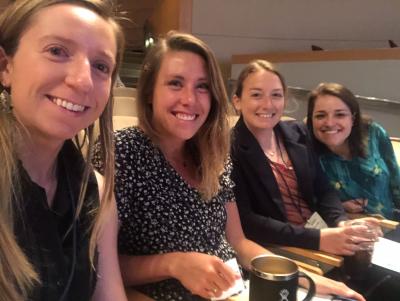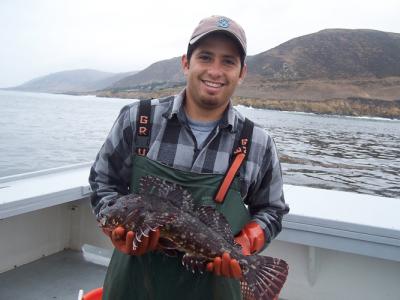As far back as she can remember, Valerie Termini knew she wanted a future in ocean conservation, but figuring out how to navigate a career caring for the oceans without becoming a scientist herself felt somewhat murky. Leaning towards policy instead, Termini soon found her groove thanks in part to a year-long California Sea Grant State Fellowship.
Nearly two decades later, she now holds the title of Chief Deputy Director of California’s Department of Fish and Wildlife and oversees a staff of over 3,400 employees managing California’s diverse fish, wildlife and plant resources and habitats.
Termini isn’t the only California Sea Grant state fellow to steer her way toward a meaningful and impactful career. In the 36 years since the program’s start, over 300 aspiring researchers and future policymakers have spent year-long forays in the program polishing their best skills and discovering new strengths, each joining a much wider network of past fellows that have spread coast-to-coast.
“That’s one of the secret powers of this program,” says Termini. “We now have California Sea Grant fellows throughout the halls of power that influence good policymaking everywhere.”
For Amber Mace, a state fellowship in 2005, immediately followed by a Knauss Fellowship in 2006, placed her elbow-to-elbow with both state and federal lawmakers and their staffs.
“Without a doubt, Sea Grant has been foundational to my entire career,” Mace says.
Eighteen years after completing her California Sea Grant state fellowship, Mace holds the Chief Executive Officer title at the California Council on Science and Technology where she works to provide scientific advice to the state on issues including disaster resilience, climate, water and energy policy. But it was her time as a fellow at the California Natural Resources Agency that first propelled her career. That year was spent working closely with Brian Baird, who served for nearly two decades years as the Assistant Secretary for Ocean and Coastal Policy under California Governors Brown, Schwarzenegger, Davis and Wilson.
“Brian was an excellent and inclusive mentor. I helped staff him on interagency working groups and federal task forces. That experience provided an important window for me to understand how policy gets made and how to show up in a professional way,” she says. “He introduced me to everyone and delegated work to me so I could learn firsthand how to write talking points and do background research ahead of meetings. The experience taught me a lot and was well timed for my next transition to D.C.”
A few years later, Mace helped pass the state fellow baton on to others during her stretch at the Ocean Protection Council where she hosted and mentored fellows and helped to expand the program. Despite the years that may separate their experiences, Mace says there are certain traits fellows have in common.
“A key attribute of a California Sea Grant Fellow is we’re adaptable, we learn quickly, we build skills and if we can’t do something, we’re committed to figuring it out,” says Mace.
While some fellows go into the program with a clear vision of where they’re headed, others use the opportunity to listen to what might be calling them. Elena Perez’s time as a state fellow at the California Coastal Commission in 2015 exposed the recent master’s graduate to policy research and planning at the state level, but it also opened her eyes to a then-newer area of policy — environmental justice.
“I could see there were gaps in decision making when it came to marginalized communities when it came to issues like sea level rise, coastal resilience and how it impacts risk along the coast,” says Perez. “That’s when I started thinking about underserved populations and their heightened vulnerabilities and how to make sure these populations are represented and considered when it comes to making decisions.”
It's a passion that continues to guide Perez in her current position as Ocean Resilience Lead at the World Economic Forum in New York, where she works with UN high-level champions to determine how to finance coastal resilience globally while helping protect the most vulnerable communities from climate impacts.

Lily Tsukayama had envisioned herself in a state-level career after completing her master’s degree at Bren School of Environmental Science and Management at the University of California, Santa Barbara. Instead, she found herself working at the Port of San Diego in 2017, the agency’s first year as host. There she served as a project manager on a pilot program with the San Diego Ocean Planning Partnership — a collaboration between the Port and the State Lands Commission.
“I had never envisioned myself working for an agency like the Port before, but we do a lot of work with the community here and a lot of public outreach and engagement,” she says. “The people at the agency saw potential in me that I didn’t realize myself. And when I think back on what’s important to me, working at a local agency really has aligned with what I’m interested in doing. I’ve felt so fortunate to be placed where I’ve been placed.”
Others, like Laura Engeman, have come full circle since their time as fellows. In 2006, during her year as a state fellow, she was placed at the then-new Ocean Protection Council where she got her hands wet on a variety of topics and projects. Today she holds a joint appointment as a Coastal Resilience Extension specialist for California Sea Grant and the Center for Climate Change Impacts and Adaptation at Scripps Institution of Oceanography.
“That year gave me a unique opportunity to understand and be involved in many of the contemporary challenges the state was facing on coastal policy and management. I was able to lead one of the state’s first working groups on offshore wind and wave energy development and worked on things like marine spatial planning, which was then a brand-new concept. I also had the opportunity to work with fishermen to pilot a new research project,” she says.
“It’s also how I learned how state funding is allocated to cities for coastal management. Understanding how investments are made and how to funnel science through those investments remains a huge help to me today.”
Strengthening the program
In its infancy, only two or three fellows would go through the program each year. But that number, along with the number of hosts, has steadily increased. In 2024, California Sea Grant is expected to add 24 additional state fellows to its ranks.
While glowing state fellow stories abound, the program hasn’t always been smooth sailing. In some years, host budgetary woes curtailed the number of participating fellows. Ensuring mentors could keep fellows engaged in meaningful work throughout the year was sometimes a challenge, too. So was determining exactly how many fellows the program could support each year. Too many and the program could be hard to manage; too few and pressure to grow the program would come into play.
When current California Sea Grant Director Shauna Oh took over the program in 2000 as the Marine Program Specialist, she also changed the program’s funding model, creating an incentive for hosts.
“The program wasn't stable when it was funded exclusively by the hosts, whose budget could fluctuate depending on the year," says Oh. "Instead, we started investing Sea Grant funding to help offset costs for hosts and engaging new host partners, who may not have had enough funding to participate. That's how the program was able to expand and grow."

Oh’s goals are to diversify the program further, making it accessible to more students who better reflect the population of California — a move that will help diversify the agencies as well.
All told, 37 unique hosts have participated in the program, with many taking part each year. Part of the draw is the access to a variety of prescreened qualified applicants. Indeed, each year, many hosts go on to hire their fellows full-time.
While Mike Murray, deputy superintendent for programs at NOAA’s Channel Islands National Marine Sanctuary isn’t able to offer fellows staff positions each year, he has played host to 15 fellows so far and many of them have continued on to work within NOAA.
“In the beginning we thought this might be an affordable way to get a helper on staff for a year, but I realized quickly the true value is watching fellows grow and seeing them succeed. Their success is my success,” he says.
And it's clear that it’s California’s success as well.
About California Sea Grant
NOAA’s California Sea Grant College Program funds marine research, education and outreach throughout California. Headquartered at Scripps Institution of Oceanography at the University of California San Diego, California Sea Grant is one of 34 Sea Grant programs in the National Oceanic and Atmospheric Administration (NOAA), U.S. Department of Commerce.